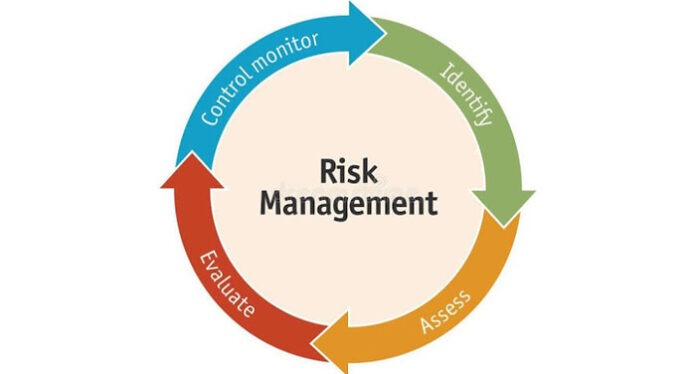Organisations of all sizes and sectors face uncertain events that threaten their survival. The more the landscape, the more vital it is that risk exposure is addressed effectively.
The advent of artificial intelligence (AI) has presented an opportunity to revolutionise the way we use data analytics in corporate risk management, overhauling traditional methods that struggle to keep pace with today’s enormous amounts of data.
In this article, we’ll explain how AI could enhance data analytics in corporate risk management with examples and discuss the key concerns about harnessing this technology.
Understanding predictive analytics in corporate risk management
Risks are inherent in most business activities, representing significant threats to many businesses’ survival. The most common types of risk include:

- Strategic risks, which threatenan organisation’s long-term plans and objectives.
- Operational risks, or challenges to an organisation’s ability to carry out its day-to-day activities.
- Compliance risks, such as tax regulation violations that often result in productivity losses or financial penalties.
- Legal risks, or issues concerning corporate law that could result in penalties and legal action over regulatory issues and disputes.
- Financial risks, which undermine the financial standing of an organisation.
- Security risks, or hazards associated with an organisation’s digital or physical assets.
While data and analytics enable decision-makers to better predict and ward against risks, the sheer volume of data can often be time-consuming and unwieldy to handle – drawing resources away from mission-critical tasks and exposing organisations to costly mistakes.
But it’s possible to bypass these downsides by leveraging AI. Using advanced technologies like machine learning, AI can quickly analyse huge datasets and make predictions regarding key risks and decisions.
So, what are some examples of how AI-driven analytics can be used to assess and mitigate risks in corporate settings?
- Enhancing fraud detection and prevention
Artificial intelligence can play a vital role in detecting and preventing fraudulent activities. By unusual detecting patterns and anomalies in data, AI-powered fraud management systems can indicate fraudulent activities such as payment fraud, identity theft and phishing attacks that threaten businesses, as well as alert the relevant authorities.
- Mitigating compliance risks
AI is also becoming widely used for regulatory compliance, addressing common challenges and systematic issues commonly faced in this domain. Integrated into enterprise software applications, artificial intelligence can increase the efficiency and effectiveness of compliance programs across a variety of industries and sectors. The most potent benefits of this lie in reducing instances of human error, which can creep into compliance activities through poor due diligence, outdated technology and even ineffective processes.
While leveraging data and analytics assists decision-makers in predicting and addressing these risks, the sheer magnitude of data often proves unwieldy and time-consuming to manage. This can divert resources from mission-critical tasks, leaving organizations vulnerable to costly mistakes. However, AI offers a solution by efficiently processing large datasets through advanced technologies like machine learning, enabling the generation of predictions related to key risks and decisions.
Harnessing AI for Risk Mitigation: Examples
1. Enhancing Fraud Detection and Prevention: AI plays a pivotal role in identifying and preventing fraudulent activities. By analyzing patterns and anomalies in data, AI-powered fraud management systems can detect payment fraud, identity theft, and phishing attacks that threaten businesses. These systems can also alert relevant authorities, preventing further damage.
2. Mitigating Compliance Risks: AI is increasingly being integrated into enterprise software applications to enhance regulatory compliance. By addressing common challenges and systematic issues, AI improves the efficiency and effectiveness of compliance programs across diverse industries. It reduces instances of human error resulting from inadequate due diligence, outdated technology, and ineffective processes.
Addressing Concerns about AI in Corporate Risk Management
Despite the evident potential of AI-powered analytics in corporate risk management, several concerns merit consideration:
1. Accuracy Limitations: Skepticism persists regarding the sourcing and computation of results by AI platforms. This concern is especially pertinent in corporate risk management, where inaccuracies could have catastrophic consequences for an entire organization.
2. Accountability for Mistakes: Establishing clear lines of responsibility is imperative when AI-powered analytics are involved. As AI becomes more integrated into corporate risk management, determining who is accountable for mistakes resulting from AI-generated insights becomes crucial.
3. Complementing Human Work: While AI holds immense promise, it should ideally complement human efforts rather than replace them. Human judgment, ethics, and context remain essential in navigating complex risk scenarios.
Striking the Balance: The Bottom Line
AI has the potential to reshape the landscape of corporate risk management by breaking down barriers in harnessing data analytics for predicting and mitigating risks. Although numerous possibilities exist for applying AI in this domain, concerns are valid. Striking the right equilibrium between AI and human involvement will be pivotal in avoiding unfavorable outcomes. As organizations move forward, embracing AI as a collaborative tool alongside human expertise will be crucial for effective and resilient corporate risk management.

